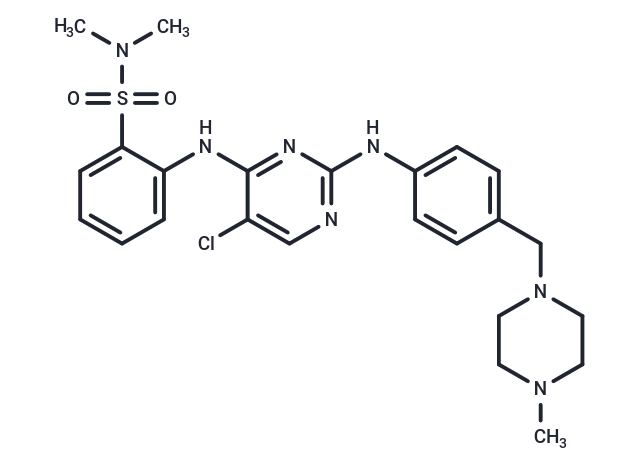Shopping Cart
- Remove All
 Your shopping cart is currently empty
Your shopping cart is currently empty

Dubermatinib (TP0903) is a potent and selective Axl kinase inhibitor.

| Pack Size | Price | Availability | Quantity |
|---|---|---|---|
| 1 mg | $30 | In Stock | |
| 2 mg | $38 | In Stock | |
| 5 mg | $61 | In Stock | |
| 10 mg | $85 | In Stock | |
| 25 mg | $148 | In Stock | |
| 50 mg | $239 | In Stock | |
| 100 mg | $369 | In Stock | |
| 500 mg | $885 | In Stock |
| Description | Dubermatinib (TP0903) is a potent and selective Axl kinase inhibitor. |
| Targets&IC50 | Axl:27 nM |
| In vitro | In pancreatic cancer cells (PSN-1), TP-0903 shows strong antiproliferative activity with IC50 of 6 M. TP-0903 also induces strong G2/M arrest by potently inhibiting Aurora A and B. [1] In CLL B cells from all the patients with CLL, TP-0903 causes a dose-dependent induction of massive apoptosis by targeting phosphorylated Axl, and overcomes CLL BMSC-mediated protection of CLL B cells from apoptosis. [2] |
| In vivo | In the adult rat hippocampus, the intracerebroventricular administration of SAG (2.5 nM) significantly increases the number of newly generated cells and extends survival of hippocampal cells. [3] In mice, SAG (20 μg/g, i.p.) effectively prevents GC-induced neonatal cerebellar developmental abnormalities. [4] |
| Kinase Assay | Axl Kinase activity assay: Test compounds are diluted to desired concentrations in kinase reaction buffer (50 mM HEPES pH 7.5, 10 mM MgCl2, 1 mM EGTA, 2 mM DTT, and 0.01% v/v Tween-20) and are briefly incubated with Axl kinase. The Axl kinase used is recombinant human Axl kinase (catalytic domain, amino acids 473-894) with a histidine tag. The reaction is initiated by the addition of ATP and fluorescein-labeled poly-GT substrate (poly Glu:Tyr, 4:1 polymer). Concentration of the various components in the assay (10 μL reaction volume) are: 1% DMSO, 93 ng/mL Axl kinase, 20 μM ATP, and 200 nM fluorescein poly-GT substrate. Following addition of ATP and fluorescein poly-GT substrate, incubation is for 60 min at room temperature, the enzyme reaction is stopped by addition of 10 μL terbium-labeled anti-phosphotyrosine PY20 antibody in EDTA-containing buffer. Final concentration of EDTA and antibody after addition to the reaction is 10 mM and 2 nM, respectively. The terbium conjugated antibody generates a time-resolved FRET signal with the fluorescein molecule (bound to the poly-GT substrate) when the substrate is phosphorylated. After one hour incubation at room temperature, fluorescence is measured with excitation of 320 nm and dual emission of 495 and 520 nm on an EnVision microplate reader. Signal is expressed in -636996terms of a TR-FRET ratio (fluorescence intensity at 520 nm to 495 nm). |
| Cell Research | For cell proliferation assays, 45 μL containing 1000 cells per well are seeded into solid white 384-well plates in appropriate media. The following day, TP-0903 is diluted in serum free growth media to 10x desired concentrations and 5 μL is added to each well. Combined compound and cells are incubated for 96 hours. Following incubation, 40 μL of ATP-Lite solution is added to each well, incubated for an additional 10 minutes at room temperature and luminescence is measured on an microplate reader[1]. |
| Alias | TP0903 |
| Molecular Weight | 516.06 |
| Formula | C24H30ClN7O2S |
| Cas No. | 1341200-45-0 |
| Smiles | CN(C)S(=O)(=O)c1ccccc1Nc1nc(Nc2ccc(CN3CCN(C)CC3)cc2)ncc1Cl |
| Relative Density. | 1.347 g/cm3 (Predicted) |
| Storage | Powder: -20°C for 3 years | In solvent: -80°C for 1 year | Shipping with blue ice. |
| Solubility Information | DMSO: Slightly soluble |

Copyright © 2015-2025 TargetMol Chemicals Inc. All Rights Reserved.